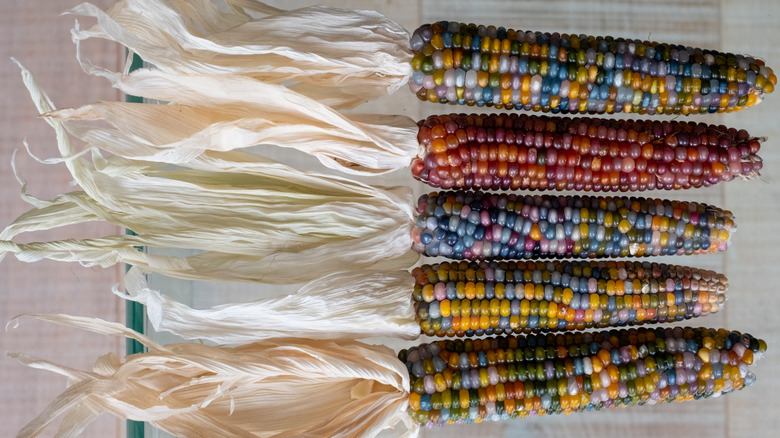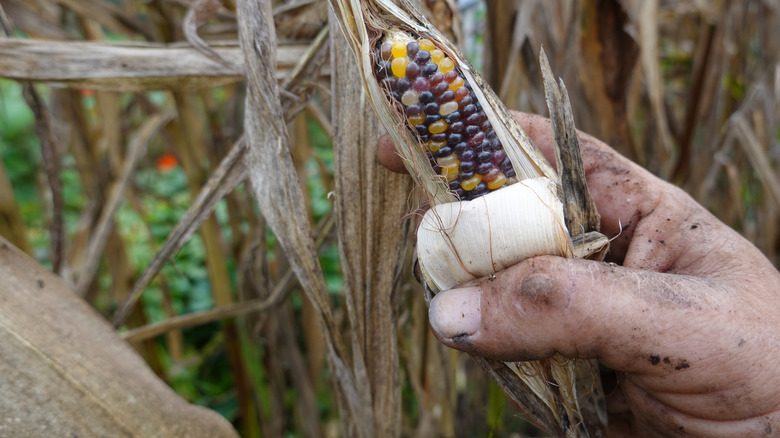Don't Cook Multicolored Corn The Same Way As The Regular Stuff
Glass gem corn is quite a sight. With kernels shimmering in blues, purples, reds, and golds, it's easy to imagine it tastes as magical as it looks. You could toss it in a pot like you would sweet corn if you wanted to, but you'd be setting yourself up for disappointment. This is flint corn and not the tender, sweet variety sold at roadside stands or grocery stores. Its kernels are hard and starchy — built for storage, not for sinking your teeth into. Instead of soft bursts of sweetness, you'd be met with an unyielding crunch that's closer to hard uncooked popcorn kernels than buttery corn on the cob.
It's important to note that all glass gem corn is flint corn, but not all flint corn is glass gem. Flint is a broader category of corn that is characterized by hard, smooth kernels. Glass gem is a particular strain with a unique and alluring appearance. Flint corn is harvested only after the husks have dried to a papery brown and the kernels have hardened completely.
At that stage, the sugars have converted to starch, which is perfect for making cornmeal or popcorn (though it pops white and not in those beautiful colors). Treat it like a grain crop with decorative beauty and not a juicy vegetable side dish. Glass gem corn that has been ground down (using a grain mill or high-powered food processor) can be turned into hot water or regular cornbread, grits, a dredge for fried catfish, or Rhode Island johnnycakes. You can even nixtamalize the dried corn to transform it into masa harina, the base for homemade tortillas and tamales.
The story and science behind glass gem corn's rainbow colors
Despite the brilliant colors that make glass gem corn look lab-grown, it actually came from decades of careful seed saving. Part-Cherokee farmer Carl Barnes started growing heirloom corn varieties to reconnect with his heritage. Through the process of selectively breeding varieties of corn with unusual colors, he created this particular cultivar. Barnes passed on some seeds to grower Greg Schoen, who crossed them with a popcorn variety, amplifying the vivid hues and glossy finish. Those seeds were later shared with seed saver Bill McDorman, who helped make them more accessible. Now, gardeners can plant them knowing each cob will yield a colorful surprise.
The colors come from genetic variation in the pigments (anthocyanins and phlobaphenes) that form in the kernel's outer pericarp and aleurone layers. Carotenoids color the endosperm underneath. As scientist Kirk Maxey explains it, "The endosperm forms the substance of the corn kernel, and it is the canvas, while the thinner pericarp and aleurone layers are like paint layered over this base color." Effectively, each kernel is genetically unique, which is why no two cobs look alike. That unpredictability is part of the charm and what makes it such a popular decoration when autumn rolls around.
Once harvested, the ears should be air-dried in a cool, dry location for several weeks to prevent mold. Because it's an heirloom variety, you can also save seeds for next year — just make sure you plant it far enough from other corn to avoid cross-pollination. Properly stored in a paper bag in a cool, dry place, those seeds will remain viable for planting or grinding for years.

